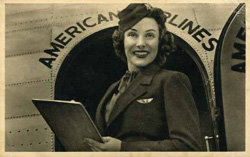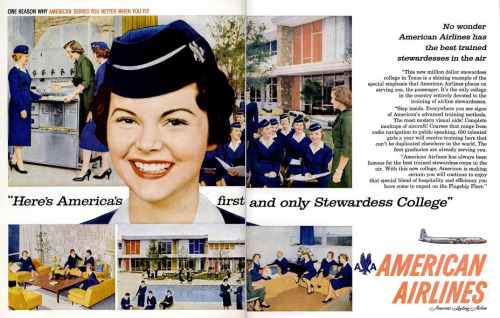Put aside the fact that passengers didn't bring their 5 million bags on the aircraft (as they do today), the overhead racks were used primarily for hat boxes, coats, pillows & blankets. Fine China was actually used to serve passengers, gloves were used in flight by the Attendants, kids (and some adults) were able to actually visit the cockpit during cruise altitude.
Imperial Airways of the United Kingdom had "cabin boys" or "stewards"; in the 1920s. In the USA, Stout Airways was the first to employ stewards in 1926, working on Ford Trimotor planes between Detroit and Grand Rapids, Michigan. Western Airlines (1928) and Pan American World Airways (Pan Am) (1929) were the first US carriers to employ stewards to serve food. Ten-passenger Fokker aircraft used in the Caribbean had stewards in the era of gambling trips to Havana, Cuba from Key West, Florida. Lead flight attendants would in many instances also perform the role of purser, steward, or chief steward in modern aviation terminology.
The first female flight attendant was a 25-year-old registered nurse named Ellen Church. Hired by United Airlines in 1930,she also first envisioned nurses on aircraft. Other airlines followed suit, hiring nurses to serve as flight attendants, then called "stewardesses" or "air hostesses", on most of their flights. In the United States, the job was one of only a few in the 1930s to permit women, which led to large numbers of applicants for the few positions available. Two thousand women applied for just 43 positions offered by Transcontinental and Western Airlines in December 1935.
Female flight attendants rapidly replaced male ones, and by 1936, they had all but taken over the role. They were selected not only for their knowledge but also for their characteristics. A 1936 New York Times article described the requirements:
"The girls who qualify for hostesses must be petite; weight 100 to 118 pounds; height 5 feet to 5 feet 4 inches; age 20 to 26 years. Add to that the rigid physical examination each must undergo four times every year, and you are assured of the bloom that goes with perfect health."
Originally, female flight attendants were required to be single upon hiring, and were fired if they got married, exceeded weight regulations, or reached age 32 or 35 depending on the airline. In the 1970s the group Stewardesses for Women's Rights protested sexist advertising and company discrimination, and brought many cases to court. The age restriction was eliminated in 1970. The no-marriage rule was eliminated throughout the US airline industry by the 1980s. The last such broad categorical discrimination, the weight restrictions, were eliminated in the 1990s through litigation and negotiations. By the end of the 1970s, the term stewardess had generally been replaced by the gender-neutral alternative flight attendant. More recently the term cabin crew or cabin staff has begun to replace 'flight attendants' in some parts of the world, because of the term's recognition of their role as members of the crew.
It was an easier job then....for the most part. Passengers didn't have to worry about getting to the airport 2-4hours prior to scheduled departure to wait through security checkpoints. However that did change and metal detectors were installed when talks of highjacking started to come around, and then of course the events after 9/11 which changed the history of aviation as it once was.
The majority of a flight attendant's duties are safety related. Prior to each flight, flight attendants attend a safety briefing with the pilots and lead flight attendant. During this briefing they go over safety and emergency checklists, the locations and amounts of emergency equipment and other features specific to that aircraft type. Boarding particulars are verified, such as special needs passengers, small children travelling as unaccompanied or VIPs. Weather conditions are discussed including anticipated turbulence. Prior to each flight a safety check is conducted to ensure all equipment such as lifevests, torches and firefighting equipment are on board, in the right quantity, and in proper condition. Any unserviceable or missing items must be reported and rectified prior to takeoff. They must monitor the cabin for any unusual smells or situations. They assist with the loading of carry-on baggage, checking for weight, size and dangerous goods. They make sure those sitting in emergency exit rows are willing and able to assist in an evacuation and move those who are not willing or able out of the row into another seat. They then must do a safety demonstration or monitor passengers as they watch a safety video. They then must "secure the cabin" ensuring tray tables are stowed, seats are in their upright positions, armrests down and carry ons stowed correctly and seat belts fastened prior to takeoff. All the service between boarding and take-off is called Pre
Take off Service.
Once up in the air, flight attendants will usually serve drinks and/or food to passengers. When not performing customer service duties, flight attendants must periodically conduct cabin checks and listen for any unusual noises or situations. Checks must also be done on the lavatory to ensure the smoke detector hasn't been deactivated and to restock supplies as needed. Regular cockpit checks must be done to ensure the pilot's health and safety. They must also respond to call lights dealing with special requests. During turbulence, flight attendants must ensure the cabin is secure. Prior to landing all loose items, trays and rubbish must be collected and secured along with service and galley equipment. All hot liquids must be disposed of. A final cabin check must then be completed prior to landing. It is vital that flight attendants remain aware as the majority of emergencies occur during takeoff and landing. Upon landing, flight attendants must remain stationed at exits and monitor the airplane and cabin as passengers disembark the plane. They also assist any special needs passengers and small children off the airplane and escort children, while following the proper paperwork and ID process to escort them to the designated person picking them up.
Flight attendants are highly trained to deal with a wide variety of emergencies,and are trained in First Aid. More frequent situations may include a bleeding nose, illness, small injuries, intoxicated passengers, aggressive and anxiety stricken passengers. Emergency training includes rejected takeoffs, emergency landings, cardiac and in-flight medical situations, smoke in the cabin, fires, depressurization, on-board births and deaths, dangerous goods and spills in the cabin, emergency evacuations, hijackings, water landings, and sea, jungle, arctic, and desert survival skills
Sure, the climate has changed, the clientele has changed, the demand for travel has changed. I would LOVE for things to go back to the glory days from yesteryear. Seats have changed, technology has changed, and of course, in some cases, the role of the Flight Attendant has changed too.
Flight Attendants not only have to watch out for safety, but we have to keep a close eye on potential dangers to the flight itself. On top of that, service must be at an all time high, as well as simple knowledge of complicated new seats that airlines try to compete with for the business traveler.
With the weight standards, marriage restrictions, and other changes over the years, you will now find many flight attendants to be larger in size, married, and sometimes not dressed to the high standards that the airline set back in the day.




